Kashmir: Magic in Two Movements
“During those three weeks, I: met two kings and dined in their palaces; spent the night in one palace; watched a devil-dance in a Buddhist monastery; paid $100 for a beautiful made-to-measure suit which was ready in 36 hours; watched two marmots fighting on a bleak hillside in Zanskar; ate a picnic lunch under a 30-foot waterfall; watched monks at early morning prayers in a monastery hanging off the side of a mountain; sat on a houseboat balcony on Dal Lake watching the sun go down; and stayed in two 5-star hotels and in two places where the lavatory was a hole in the ground. Plenty of variety in Kashmir.”—By Michael House
Polemicist on Holiday
By Michael House, FRGS
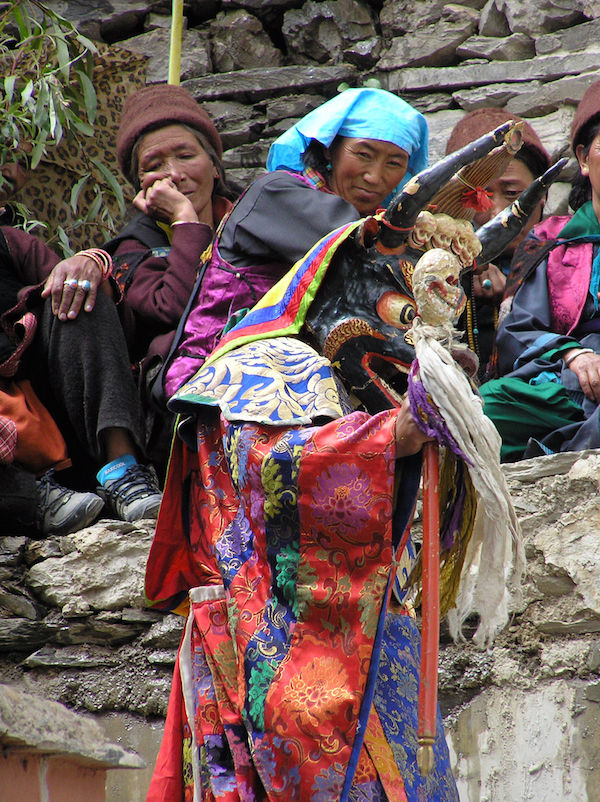
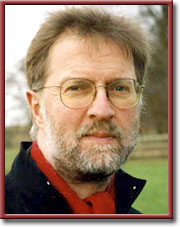 KINGS SUTTON England—(Weekly Hubris)—9/21/2015—There is a myth abroad, a hangover from a previous period of violent unrest, that Kashmir is an unsafe travel destination. I hope what follows will help to dispel the myth.
KINGS SUTTON England—(Weekly Hubris)—9/21/2015—There is a myth abroad, a hangover from a previous period of violent unrest, that Kashmir is an unsafe travel destination. I hope what follows will help to dispel the myth.
Of course, there are always dangers in traveling in remote places. Landslides in the Himalayas are common, especially in the monsoon season. But the only time I felt unsafe during three weeks in Kashmir in July was crossing the road in Srinagar in the rush hour.
During those three weeks, I: met two kings and dined in their palaces; spent the night in one palace; watched a devil-dance in a Buddhist monastery; paid $100 for a beautiful made-to-measure suit which was ready in 36 hours; watched two marmots fighting on a bleak hillside in Zanskar; ate a picnic lunch under a 30-foot waterfall; watched monks at early morning prayers in a monastery hanging off the side of a mountain; sat on a houseboat balcony on Dal Lake watching the sun go down; and stayed in two 5-star hotels and in two places where the lavatory was a hole in the ground. Plenty of variety in Kashmir.
We were a party of five: Bill (77), Peter (77), Alan (72) and Diane and me, the youngsters of the group. There was some trekking and much climbing to remote monasteries and villages where motorized transport was impossible. It was brought home to me again and again that age is a number, not a condition.
We flew to Delhi and then, after an hour’s sleep, were whisked off to the airport to fly to Leh, the capital of Ladakh, the north-eastern province of Kashmir. At an average elevation of around 13,000 feet, Ladakh is one of the highest inhabited districts in the world, with mountain passes of up to 18,000-feet-plus (by way of comparison, Mont Blanc, the highest mountain in Europe, is 15,777 feet). Altitude sickness, headaches, and nausea are normal until one is acclimatized. Sadly, we only stayed one day in this fascinating town, crossroads of trans-Himalayan trade caravans for centuries, since our main destination was the remote valley of Zanskar, whose capital of Padum is three days’ hard driving from the nearest civilian airport, over roads where 20 mph is a reckless speed.
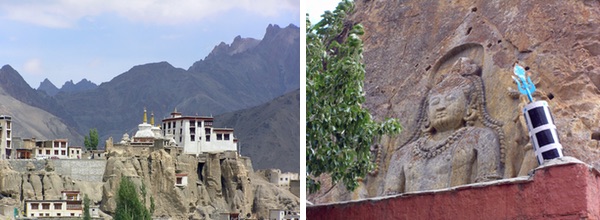
En route to Kargil, the administrative capital of the Zanskar region, we were taken to the 10th-century Buddhist monastery complex at Alchi. Tucked away in a fold in the mountains off from the main caravan routes, Alchi survived the Dogra invasions of 1830 in which many gompas (monasteries) were sacked. So the superb medieval murals, comprising thousands of tiny images of the Buddha, are intact.
We passed the great monastery of Lamayuru, a miracle of architecture and engineering amid the austere moonscape of twisted and striated rock. At Mulbeck, we visited a 30-foot Buddha, carved from an enormous rock, dating from the 8th century A.D., similar to the sculptures the Taliban vandalized at Bamian.
Kargil is a lively, squalid, friendly North Indian town, the point on the Leh-Srinagar highway where Buddhist culture dies out and the Islamic begins to predominate, as emphasised by the 4 a.m. Call to Prayer, strongly amplified, which jerked me out of a dreamless sleep at the comfortable Greenland Hotel. Kargil boasts the Central Asian Museum, a fascinating collection of artifacts left in the family caravanserai run over many years by the grandfather of the museum’s creator. This was a highlight.
Leaving Kargil, we set off south into Zanskar proper, a Tibetan Buddhist community the Chinese imperialist barbarians have not been able to destroy. From Kargil to the historical capital of the region, Padum, is a 16-hour drive. This is not a terrain for night-driving, so travelers break their journey at Rangdum, where they stay at the optimistically-named Nun Kun Deluxe Tent Camp, situated in a wide river valley in the shadow of the Rangdum gompa. The scenery is breathtaking: a wide river valley, walled in by fantastically striped and colored cliffs, with snow-capped mountains behind, in particular the majestic twins, Nun and Kun, both at 23,000-feet-plus.
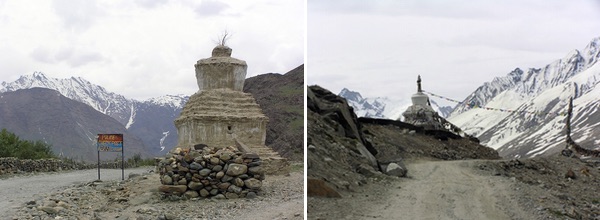
The Deluxe Tent Camp is OK for one night. The tents are waterproof —a rare monsoon downpour hit us, which I’m told is almost unique for Zanskar, so that was a relief. The food was excellent, but the hygiene arrangements left much to be desired. The highlight was a visit to the gompa, where we were shown a rather eclectic museum and the Dalai Lama’s quarters when he visits, with his religious implements, his throne and his colorfully furnished bedroom. The view from the roof of the gompa was very fine.
Next morning, it was on to Padum. Many fat, ginger-brown marmots were whistling and chattering as we drove along the valley floor, passing a spectacular glacier en route. Sometimes the river was roaring tumultuously through a narrow gorge; sometimes rolling languidly onward as the valley widened.
We stayed at the distinctly odd but endearing Hotel Rigyal, up a side-track which was mostly river—in Zanskar, you are rarely out of sight and sound of swiftly running water. Turning off the main street, we would pass the helipad which is Zanskar’s only link with the outside world between December and June, apart from a six-day trek along a frozen river bed. In the sub-zero temperatures of winter, the Zanskaris stay in their houses, weaving cloth and drinking chang—barley beer. The roofs of the houses are piled high with brushwood for fuel and in the summer women are seen with conical baskets on their backs, looking for cow-pats to dry and burn in winter. This fuel is provided by the dzo, male offspring of the yak and the cow, or the dzomo, the female offspring.
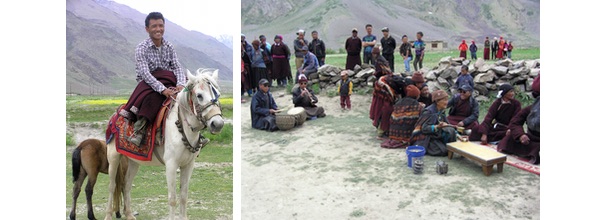
The hotel was run, apparently single-handedly, by a charming young man called Gensen who produced excellent breakfasts and dinners. If you wanted a shower, you asked him for a bucket of hot water, which you then poured over yourself from a large plastic mug.
We made Padum our base for five days, apart from one night when we stayed at the palace of the King of Zangla. The King, a retired teacher, reigns over four villages in the Chamba region of Zanskar. His palace is a large Tibetan-style house, with a beautifully carpeted reception room/kitchen where we sat cross-legged on the floor to eat and talk.
An old lady sitting in the corner, a stranger to modern dentistry, turned out to be the Queen—I thought she was the King’s mother. In fact she was the daughter of the old King of Zangla, and her husband was the King of Padum’s younger brother. Clear? These charming, friendly people made us very welcome in their home. We were served cinnamon tea, chang and arak, a distilled spirit with added sulphuric acid—best avoided. The bedding was comfortable, but the plumbing consisted of a hole in the floor, the proceeds no doubt to be spread on the fields next year—ecologically sound but whiffy.
We visited the old palace, a picturesque ruined castle on a nearby hill. The first European to study the Tibetan language systematically, the Hungarian scholar Alexander Csoma de Koros spent the winter of 1823 studying in a tiny room in the palace. He later produced a Tibetan-English dictionary and a grammar. A Hungarian organization is undertaking some restoration of the castle and has put up commemorative plaques.
Every village we visited displayed a strong Buddhist influence. In the approaches to villages, there were rows of chortens, sometimes called stupas, religious shrines to the dead. There were also manis, walls of rocks topped with large pebbles on which were inscribed the ubiquitous invocation om manipadme hum, “hail to the jewel in the lotus,” and other carved images. Every village had its own giant prayer wheel, over 8 feet tall, which rang a bell when given one complete turn, sending prayers floating to heaven. Prayer wheels come in all shapes and sizes: we saw tiny ones where the wheel is turned by solar power; the hand-held version; and one turned by a water-mill effect. Colorful prayer flags were everywhere, printed with a “wind-horse” and the usual prayers. Even to the militantly irreligious such as I, the physical manifestations of Buddhism were very attractive.

The King of Padum came to our hotel for dinner. He had excellent English and happily answered interminable questions about his modest kingdom. He worried about the growing encroachment of Muslims in Zanskar. But he had many children and grandchildren, so the family was fighting back. He said that polyandry had finally died out a few years ago. Conversions to Islam were causing community tensions, and inter-marriage, commonplace for centuries, no longer happened. The King has no official powers, but enjoys high status in the community and is called on by locals to arbitrate in disputes and resolve problems.
Apparently, some 350 years ago, the King of Padum sent to Kashmir for a butcher and a secretary—one to prevent Buddhists suffering bad karma from slaughtering animals; one to communicate with the Moghuls in Urdu. The two Muslims were given local wives, and so the Islamic community started to grow.
While we were at Padum, our wonderful guide Namgyal Dorjay devised stimulating day trips for us. One visit was to a remote monastery far up a side valley but, sadly, the man with the key was away, so we ended up having a picnic lunch in the sunshine outside the gates, feeding the two donkeys who joined us. Surprisingly, donkeys don’t like bananas.
Wedding celebrations in Zanskar last three days. On day one, everyone, invited or not, congregates in the groom’s family home and is entertained, the huge main room containing upwards of 50 people of all ages, eating and drinking. Visitors from nearby villages ride over on horses bedecked with gorgeous colorful saddle-rugs, which made me green with envy. Next day, the bride’s family plays host and, on the third day, the ceremony takes place. Our guide’s cousin was getting married, and we were invited to day one, a high-point of the trip, where we were welcomed with that warm-hearted courtesy that is the hallmark of Zanskaris.

We paid two visits to Karshagompa, across the plain from Padum, a series of whitewashed buildings set into a vertical cliff-face. It is the largest gompa in Zanskar, with 150 monks. The first visit was early in the morning, when we were privileged to enter the prayer-room to watch the monks at their devotions, hypnotic chanting accompanied by sonorous drum-beats. It was solemn but informal—monks would drop out for a while to be served a bowl of tea, before rejoining the chants—and we were encouraged to walk around the room (always clockwise) and take photos.
The second visit was more spectacular. This was the second day of the annual festival devil-dance, a ceremony designed, as far as I could work out, to keep evil spirits at bay for the year. The gompa was heaving, with locals lining the roof, and pushy German tourists bagging the best seats in the stalls. The local police chief sat in a gallery surrounded by fluttering flunkies. A jobsworth army NCO was constantly moving the lower orders out of the reserved seats. The abbot’s throne was reserved for a portrait of the Dalai Lama. Beside it sat the abbot himself, equipped with his ritual objects, his bell, his dorje (thunderbolt representation) and an ingenious little hand-drum shaped like an hour-glass with two surfaces. Two metal balls are attached to chains and, by swiveling the handle, double-drumming is produced.
Each of the performers would appear at the top of steep steps by the side of the square, before curvetting down to the sound of booming drums. One man, with a huge sword, the Master of Ceremonies, had his face covered with bandages as in “The Invisible Man.” Next on the scene was a monk with a huge papier-mâché head, looking like a dwarf with a bad toothache. Then came a procession of lamas in fantastic head-dresses, blowing huge horns and leading a yak, a horse, and a dog around the arena.
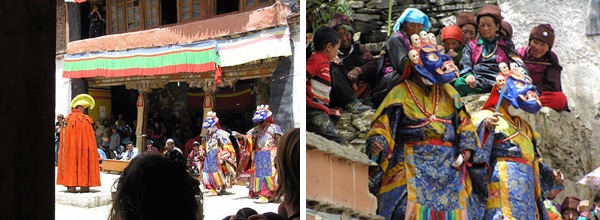
Then the dancers came down the staircase, in exquisite silk robes and wearing masks of stylized animals embellished with tiny skulls. They performed a stately gavotte-like circular dance, with ritualized steps, to a cacophony of instruments. It was hypnotic.
The locals were all in their best clothes, battered, shabby, but elegant and picturesque, clearly handed down from generation to generation.
Soon after, we left the Zanskar Valley, with great regret, to make the two-day journey to Kargil and thence west over the passes to Srinagar. I have made many hair-raising journeys in Greece, India, and Pakistan, but the drive over the Zoji-La, the only road-route from Leh to the Vale of Kashmir, was in a class of its own: a narrow track, on one side a cliff face, on the other a sheer drop of hundreds of feet to the river, many vehicles coming the other way. After getting clear of the pass, we learned that landslips had blocked the road in three places. So an 8-hour journey took 30 hours. We spent the night in the car, occasionally waking our driver so he could make a short spurt forward, passing the lorries and buses anchored on the verge above the river. At dawn, we decided to walk over the land slips, past semi-submerged shops and houses in the villages. Eventually, we cleared the mudslides and managed to get mini-buses to take us on to Srinagar. Travel tip: if you want to travel between Leh and Srinagar, fly.
The verdant Vale of Kashmir could not be more different than the stunning but bleak austerity of Ladakh and Zanskar. It was good to see trees again. Dal Lake shimmered in the sunshine, with its dignified lines of houseboats and its flying shikiras, the punt-like water taxis that convey people to their boats, or that sell flowers, seeds, saffron, and almost anything you can think of.

We stayed for two nights in a floating palace called the Chicago houseboat, very much monumental brown furniture and twilight-of-the-Raj décor. But first, after our ordeal and our lost night’s sleep, a night in a five-star hotel in the hills above the lake. Wonderful food, a swimming pool: a perfect foil to the hard work of travel in the Himalayas.
Srinagar has many delights, including: the wonderful “Fashion House,” tailors creating made-to-measure suits in two days for pocket money; a bookshop that publishes reprints of rare out-of-print travel books on the region; “Suffering Moses,” long-established seller of papier-mâché boxes, wood carvings, shawls, and embroideries; the famous Mughal gardens such as the Shalimar; lammergeiers floating on the thermals above the lake; and the majestic Jamia Masjid mosque. I even found a solderer, a Sikh in a tiny booth, to weld together my broken sunglasses.
I commend Kashmir in all its varied aspects most strongly. Kashmir needs and deserves visitors. Go soon.
![]()
Note: All photographs for this essay were taken by Dr. Diane Fortenberry. The trip was organized by the Royal Society for Asian Affairs.
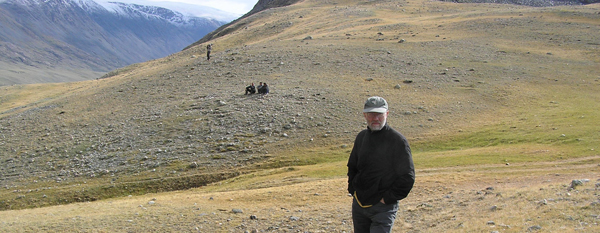
4 Comments
Will
Lord! I do love this kind of travelogue, and this particular journey is spectacular! What a joy to find this here!
Michael House
Glad you liked it. Hope you sample the real thing!
Anita Sullivan
I recently read Alexandra David-Neel’s “Magic and Mystery in Tibet,” which put me in absolute awe for the Tibetan Buddhist tradition and the varying levels of religious folks who (used to) practice it. I’m relieved to know this tradition still thrives. Thank you so much for sharing your marvelous travelogue with us! More! More!
Michael House
Thank you for those kind words. It is very important that Tibetan Buddhist communities continiue to thrive, against the day when Tibet is no longer under the Chinese jackboot, and Tibetans can relearn the old ways. No empire lasts forever, and the Chinese gulag will implode one day. I’m glad you like Alexandra David-Neel, a truly amazing woman. I recommend her book “My Journey to Lhasa.”